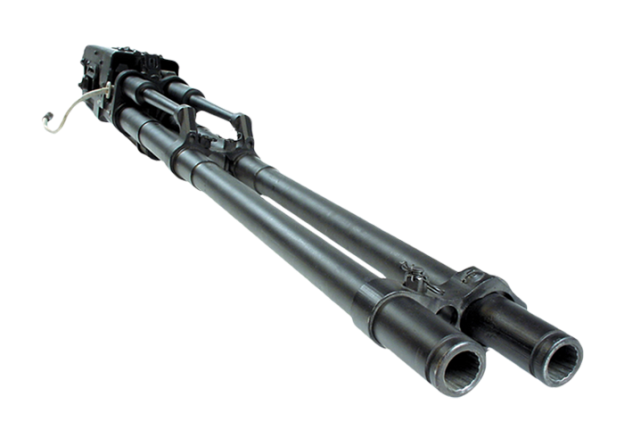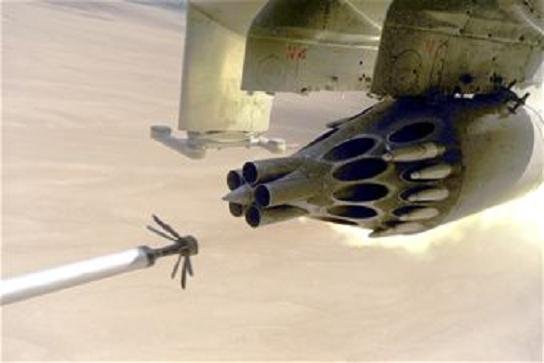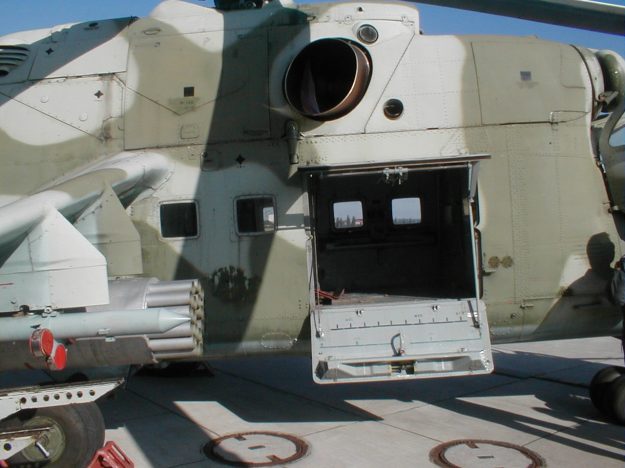The Mi-24 (NATO designation Hind) is one of the most widely-known assault helicopter gunships in the world, and remains in service with at least 50 air arms.
The Mi-24 was developed from the tried and tested Mi-8 multirole transport helicopter and was first flown in V-24 prototype form in 1969. Production commenced in 1971 and ceased in 1991. Over 2,300 Hinds of all variants were produced.
The definitive initial production variant was the Mi-24D Hind-D (Mi-25 for export). This introduced heavily-armored, stepped cockpits ant an undernose gun turret. Vital components of the helicopter are also armored. This gunship has a crew of three and can carry up to 8 fully-equipped troops.
Russia to start fitting Mi-24 gunships with Vitebsk electronic warfare system: HERE
From 1976 to 1978, the Hind-D was joined in service by the up-engined Mi-24V Hind-E (export Mi-35), which also featured improved armament of tube-launched 9M114 Shturm (AT-6 Spiral) ATGMs.
Mi-35M (Hind E): Here
Mi-24 Super Hind: Details
9K114 Shturm

The 9K114 Shturm is an anti-tank missile system of Soviet origin. It was developed in the early 1970s and is employed since 1976. The system is called 9K114 Shturm and is missile is known as the 9M114 Kokon. In the West the NATO reporting name AT-6 Spiral is used often. The 9M114 was designed to provide attack helicopters with a more capable anti-tank missile than the Falanga (AT-2). Besides helicopters it is also used on vehicles and ships.

The 9M114 has a better performance than the older Falanga (AT-2) and Malyutka (AT-3) in range, penetration and accuracy. During Western tests accuracy proved poor while Russian sources claim 75 to 85 percent effectiveness in the Afghan war. The original 9M114 missiles penetrates about 560mm RHA and has a maximum range of 5 km. The 9M114M2 extends this range to 7 km and penetrates 600 to 650 mm RHA. A thermobaric version is available.
| Type | Anti-tank missile |
| Diameter | 0.130 m body, 0.36 m wingspan |
| Length | 1.625 m |
| Weight | 31.4 kg |
| Guidance | Radio command guidance |
| Warhead | 5.3 kg HEAT warhead, penetration 560 – 600 mm RHA |
| Propulsion | Solid propellant rocket motor |
| Speed | 345 m/s |
| Range | 400 m minimum, 5 km maximum |
Source weaponsystems.net
 9M114 Shturm (AT-6 Spiral) ATGMs.
9M114 Shturm (AT-6 Spiral) ATGMs.
Combat experience in Afghanistan led to the development of the Mi-24P Hind-F with a 30-mm GSh-30K twinbarrel cannon mounted on the forward fuselage. Later specialised Hind variants include the Mi-24RKR Hind-G1 NBC reconnaissance helicopter; Mi-24K Hind-G2 for artillery fire correction; Mi-24BMT minesweeper conversion and Mi-24PS for paramilitary use.
30-mm GSh-30K twinbarrel cannon

It is designed for firing with fragmentation-mine, armour-piercing-explosive and armour-piercing-tracer shells from different types of aircrafts and helicopters at air and ground targets. Operation of automated mechanism is based on use of powder gases energy.
The gun can be used on right or left feed.
The gun is produced in two modifications: GSH-30 — with length of barrels of 1500 mm installed on aircrafts “Su-25” type; GSH-30K — with length of barrels of 2400 mm, evaporative cooling system of barrels and variable rate of fire. The gun is installed on helicopters of “Mi-24P” type.
| Technical Characteristics | |
| Calibre, mm | 30 |
| Fixed resource, shot | 4000 |
| Fire control | electric 27V |
| Mass, kg | 105 (126) |
| Overall dimensions, mm, not more than length width height |
2944 (2044) 222 195 |
Source zid.ru
 30-mm GSh-30K twinbarrel cannon
30-mm GSh-30K twinbarrel cannon
At the beggining of the 21 century Mi-24s remains in widespread service, the Russian army being the most significant operator with around 700 helicopters. Other major users include Algeria, Angola, Belarus, Czech Republic, Hungary, India, Kazakhstan, Libya and Poland. The Mi-24 has seen widespread combat action, fighting in Afghanistan, Chad, Angola, Sri Lanka and, most recently, in the wars in Chechnya in 1995 and 1999. The market for upgrades is substantial, with an estimated 1 500 Hinds remaining in service. A number of programmes are available.
 Pilot Seat
Pilot Seat Gunner seat
Gunner seat
The Mi-24VM (export designation Mi-35M) is available from Mil as a staged upgrade that includes a refurbished airframe for prolonged service, Mi-28 dynamic systems, upgraded 2,194-shp (1 636-kW) TV3-117VMA engines, and MFD-equipped cockpit compatible with night vision googles, pilot’s head-up display, forward-looking infra-red, a nose turret carrying a GSh-231 23-mm two-barrel cannon, 9M120 (AT-12 Swinger) ATGMs, and compatibility with 9M39 Igla (SA-18 Grouse) air-to-air missiles. Mil proposes to upgrade around 200 Russian Federation Hinds to these standards as Mi-24VMs, but the future of this programme is uncertain.
2 x TV3-117VMA engine
 2,194-shp (1 636-kW) TV3-117VMA engines
2,194-shp (1 636-kW) TV3-117VMA engines
The TV3-117VMA turboshaft engine is used to power in civil helicopters.
The TV3-117VMA turboshaft is one of the world`s best engines as regards its fuel efficiency and weight performances. High-tech development and perfect mass-production process have ensured the engine`s superior reliability and extensive service life.
Main advantages of the engine:
- low specific fuel consumption;
- low weight-to-power ratio;
- high reliability;
- high reliability;
- long service life;
- high maintainability;
- high repairability;
- steady operation in harsh dust and smoke conditions;
- possibility of long-time operation in maritime conditions.
| Engine | TV3-117VMA | |
| 2.5- minute power rating, with one engine inoperative (OEI) (SLS, ISA): |
||
| Power, shp (kW) | 2400 (1765) | |
| 30- minute power rating, with one engine inoperative (OEI) (SLS, ISA): |
||
| Power, shp (kW) | 2200 (1618) | |
| Specific fuel consumption, kg/hp•h (kg/kW•h) | 0.210 (0.286) | |
| Cruise power condition (SLS, ISA): | ||
| Power, shp (kW) | 1500 (1103) | |
| Dry weight, kg | 294 | |
Source motorsich.com
GSh-231 23-mm two-barrel cannon
 GSh-231 23-mm two-barrel cannon
GSh-231 23-mm two-barrel cannon
| Type | Autocannon |
|---|---|
| Caliber | 23x115mm AM-23 |
| Mechanism | Gas operated, Gast principle |
| Barrel | Twin barrel, 1.000 m, rifled, 10 grooves, 575 mm right hand twist |
| Dimensions | 1.387 m long, 165 mm wide, 168 mm tall |
|---|---|
| Weight | 50 kg |
| Feeding | Single belt feed |
| Rate of fire | 3.000 – 3.400 rpm |
| Muzzle velocity | 700 – 730 m/s |
|---|---|
| Recoil | 2.900 kg recoil force |
| Remarks | Muzzle brake |
Source weaponsystems.net
General characteristics
- Crew: 2–3: pilot, weapons system officer and technician (optional)
- Capacity: 8 troops or 4 stretchers or 2400 kg (5,291 lb) cargo on an external sling
- Length: 17.5 m (57 ft 4 in)
- Rotor diameter: 17.3 m (56 ft 7 in)
- Wingspan: 6.5 m (21 ft 3 in)
- Height: 6.5 m (21 ft 3 in)
- Disc area: 235 m² (2,530 ft²)
- Empty weight: 8,500 kg (18,740 lb)
- Max. takeoff weight: 12,000 kg (26,500 lb)
- Powerplant: 2 × Isotov TV3-117 turbines, 1,600 kW (2,200 hp) each
Performance
- Maximum speed: 335 km/h (208 mph)
- Range: 450 km (280 miles)
- Service ceiling: 4,900 m (16076 ft)
-
Armament

-
Internal guns
-
- flexible 12.7 mm Yakushev-Borzov Yak-B Gatling gun on most variants. Maximum of 1,470 rounds of ammunition.
- fixed twin-barrel GSh-30K on the Mi-24P. 750 rounds of ammunition.
- flexible twin-barrel Gryazev-Shipunov GSh-23L on the Mi-24VP and Mi-24VM. 450 rounds of ammunition.
- PKB passenger compartment window mounted machine guns
12.7 mm Yakushev-Borzov Yak-B Gatling gun

The Yak-B is a late Cold War era gatling gun of Soviet origin. It was developed for use on the Mi-24 attack helicopter as a far more capable machine gun than the UB-12.7 as used in the early models of the Mi-24. The Yak-B is a much heavier weapon than a heavy machine gun, but its 12.7mm caliber is much lighter than autocannon ammunition.
The Yak-B fires the 12.7x108mm round that is commonly used in Soviet heavy machine guns. The rate of fire is 4.000 to 5.000 rpm. In the Mi-24 it is fed by a 1.470 round belt. The Yak-B proved effective against infantry in the open and soft skin vehicles. Against dug-in infantry and armored vehicles performance proved poor.

| Type | Gatling gun |
| Caliber | 12.7x108mm Soviet |
| Mechanism | Gas operated |
| Barrel | Four barrel, rifled |
| Dimensions | ? |
| Weight | 45 kg |
| Feeding | Single belt feed |
| Rate of fire | 4.000 – 5.000 rpm |
| Muzzle velocity | 810 m/s |
| Recoil | 540 kg peak recoil force |
Source weaponsystems.net
-
External stores
-
- Total payload is 1,500 kg of external stores.
- Inner hardpoints can carry at least 500 kg
- Outer hardpoints can carry up to 250 kg
- Wing-tip pylons can only carry the 9M17 Phalanga (in the Mi-24A-D) or the 9K114 Shturm complex (in the Mi-24V-F).
-
Bomb-load
-
- Bombs within weight range (presumably ZAB, FAB, RBK, ODAB etc.), Up to 500 kg.
- MBD multiple ejector racks (presumably MBD-4 with 4 × FAB-100)
- KGMU2V submunition/mine dispenser pods
-
First-generation armament (standard production Mi-24D)
-
- GUV-8700 gunpod (with a 12.7 mm Yak-B + 2 × 7.62 mm GShG-7.62 mm combination or one 30 mm AGS-17)
- UB-32 S-5 rocket launchers
- S-24 240 mm rocket
- 9M17 Fleyta (a pair on each wingtip pylon)
GUV-8700 gunpod

The large size of the gondola (3 meters) allow you to stow up to 1800 7,62x54R caliber rounds and 750 rounds caliber 12.7 × 108.
Alternatively, the Yak-B can ‘be replaced by an automatic 30mm grenade launcher AP-30 (9A800), and that’ the Air Force version of the more ‘known AGS-17infantry. With the AP-30 mounted the ammunition load drops to a maximum of 300 shots.
Aiming is done through a traditional viewfinder collimation.
Technical features
Gondala Universalnaya Vertolotnaya 8700
Name in Cyrillic: Универсальная вертолётная гондола 8700;
English name: Universal Helicopter Pod 8700;
Nationality ‘: USSR / Russia;
Type: gun-pod for helicopters;
Armament: two machine guns quadrinate GShG 7,62x54R caliber machine gun and a quadrinata Yak-B caliber 12,7 × 108 or an automatic grenade launcher AP-30 30mm;
Length: 3000 mm
diameter: 480mm
Weight
empty: 140 kg
with weapons and ammunition: 452 kg
Total loaded ammunition: 1,800 rounds cal. 7,62x54R, more ‘750 shots 12,7x108mm gauge (300 30mm for the AP-30)
Compatible aircraft: I-24/35; Mi-8/17; Ka-25; Ka-50/52.
Translated by google – Source sobchak.wordpress.com
12.7 mm Yak-B

2 × 7.62 mm GShG-7.62 mm combination

one 30 mm AGS-17

-
Second-generation armament (Mi-24V, Mi-24P and most upgraded Mi-24D)
-
- UPK-23-250 gunpod carrying the GSh-23L
- B-8V20 a lightweight long tubed helicopter version of the S-8 rocket launcher
- 9K114 Shturm in pairs on the outer and wingtip pylons
S-8 rocket
B-8V20 a lightweight long tubed
 B-8V20 lightweight long tubed pod
B-8V20 lightweight long tubed pod
UB-32-57 mm PODs
 UB-32-57 mm PODs
UB-32-57 mm PODs
Upgraded cockpit
 Upgraded cockpit
Upgraded cockpit

Source: Military Today, Wiki, luger.tistory.com
Updated Dec 14, 2016
Video Hind in Syria Operations






